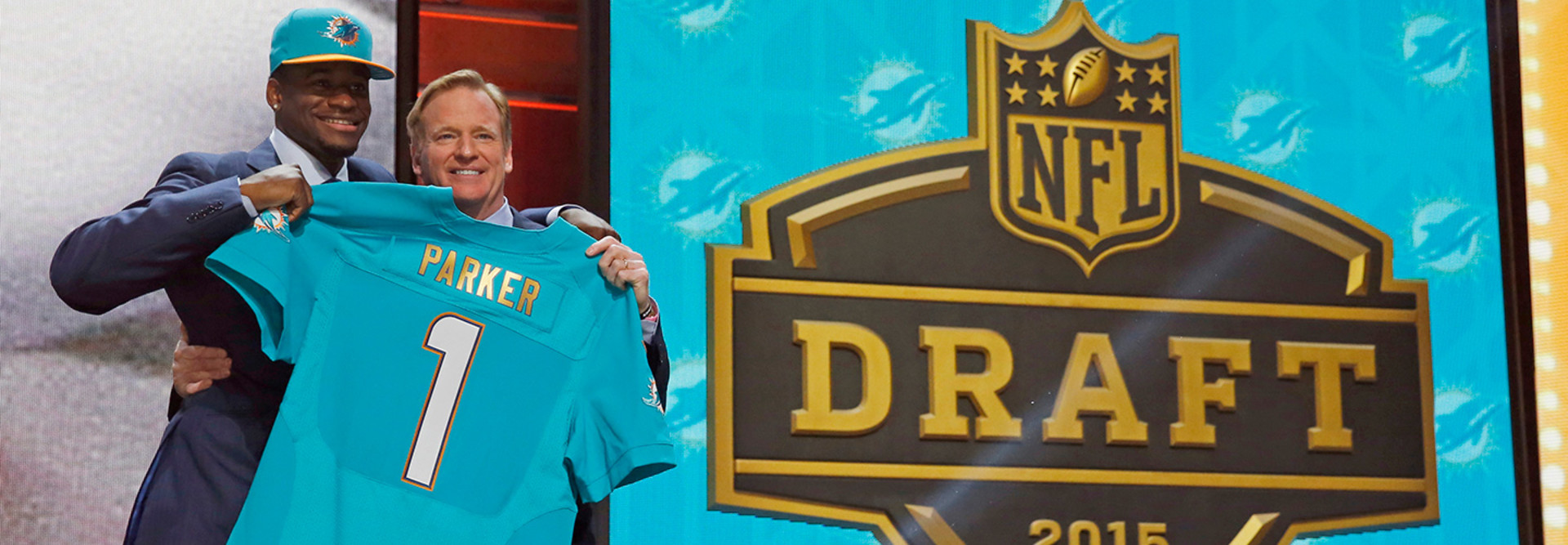The NFL Draft Integrates More with Data Analytics
As the three-day 2015 NFL Draft kicks off in Chicago, many teams are combining data analytics with traditional scouting as they evaluate and choose their next crop of new players.
NFL teams have access to more player-performance data than ever before, and many have spent the past months compiling college players’ statistics, analyzing Scouting Combine results and reviewing scouting reports as they rank each prospect and predict his chances of success in professional football.
In a pre-draft news conference last week, Miami Dolphins football operations executive vice president Mike Tannenbaum paraphrased R.C. Buford, general manager of the NBA’s San Antonio Spurs, in describing how the Dolphins use analytics to assess draft prospects.
Scouting is a combination of what coaches and scouts see, hear and believe, and it should be supplemented with numbers and data, Tannenbaum said on the team’s website.
“If you don’t have alignment in those factors, keep asking more questions. I thought that was [a] great perspective [on] how analytics over the last couple of years have been added to the process,” he said.
Nine NFL teams, including the Super Bowl XLIX champion New England Patriots, the Baltimore Ravens and the Jacksonville Jaguars, are “believers” of analytics, while seven other teams — including the Super Bowl XLVIII champion Seattle Seahawks and perennial playoff contender Green Bay Packers — have “one foot in” with analytics as they try to gain a competitive edge, according to a recent ESPN article.
The teams use analytics to not only measure player performance, but also fine-tune game strategy and manage the salary cap, says Brian Burke, founder and lead analyst of Advanced Football Analytics.
A growing number of teams are also equipping players with wearable technology, such as GPS units and RFID tags, to measure their speed and track how far they run during practices. Teams such as the New Orleans Saints use the information to measure workloads and ensure that players don’t overdo it and get injured.
“Player evaluation is just one part of it. In football, there are a lot of ways an analytical approach can help teams make better decisions,” says Burke, who specializes in analyzing game strategy and has several NFL teams as clients.
During the NFL Draft, some teams are also using data analytics tools, created by Burke, that determine draft pick value and the probability that players they are interested in will still be available when it’s their turn to pick.
The Tech Tools of the NFL Draft
Burke’s “War Room” Bayesian Draft Analysis Tool takes into account the mock drafts that experts have put together with scouting service rankings to predict when a prospect may be drafted. For example, if a team trades down in the draft to collect extra picks later in the draft, team officials may want a 95 percent probability that a player they want will still available the next time it’s their turn to pick, he said.
Burke estimates that at least a handful of teams will use his Draft Trade Evaluator, which assigns a value to each pick, makes calculations and ensures that teams get a fair deal in trades. “Say I want the 10th pick and I trade you the 16th and 82nd pick,” he says. “I would need you to throw in another pick to even things out.”
The calculator computes potential trades using three models: a conventional trade chart; an “approximate value” chart, which accounts for the player performance from the last 10 drafts to determine each pick's value; and a “surplus value” chart, which uses a discount rate to determine the value of picks in a future year.
Scouting with Analytics and Video
Many teams are getting scouting help from advanced analytics companies. For example, about half of the NFL's teams use Pro Football Focus’ advanced statistics during the season.
ProFootballFocus.com recently reviewed every play of every NCAA football game to grade each college player on a scale of 1 to 99, with 99 as the best. The grades were just released, so NFL teams can’t take advantage of the grading system for this year’s draft. But about eight NFL teams are using the website’s video and other analytics offerings for this year’s draft, says Neil Hornsby, founder and president of ProFootballFocus.com.
“We link up our data with video, so it makes the scouting process that much easier. It saves teams a lot of time,” he says.
Wearable Technology’s Role in the NFL
Wearable technology will produce vast amounts of new data on college players entering the draft in the coming years.
Last season, the NFL partnered with Zebra Technologies to put two RFID tags in every player’s shoulder pads to provide real-time player statistics, such as acceleration, total distance run and distance between players.
The technology was installed in 17 stadiums last year and will be installed in the other 14 stadiums this year, along with Wembley Stadium in London, where three games are played each year.
The data was used by TV networks that broadcast games last year. But now that every stadium will be equipped with the technology, the NFL will make all the player data available to teams this season.
The NFL has also struck a deal to use the Zebra technology in next year’s scouting combine, which will provide teams with a lot more data on potential draft picks than ever before, says Jill Stelfox, Zebra’s vice president and general manager of location solutions.
For example, the 40-yard dash has always been used to measure a player’s speed. But in the future, teams will be able to track players by position and measure their speed in increments, such as their first five or 10 yards or their first 15 to 20 yards. While a 40-yard dash may be the best measure for players at some positions, seeing how fast a lineman can run 10 to 20 yards may matter more at that position, Stelfox says.
“We’re working with NFL operations not to change the combine, but to enhance it,” she said.
During the MIT Sloan Sports Analytics Conference in February, Saints head coach Sean Payton said he expects gradual position-specific changes to be phased in.
But players have mixed feelings about a future where their skills are increasingly quantified.
“There are two sides [to] it. You have to balance between data and still have the coach’s touch because you can’t measure heart and desire with the metrics from wearable tech,” Cleveland Browns wide receiver Andrew Hawkins said at the Sloan Conference.
The technology can make you a better player when you are starting out, but after five years, the data can also show that players are getting slower, he said. When it comes to keeping, benching or releasing players, that’s where intuition — and not pure data — has to play into the decision-making of coaches and the front office.
“You still can’t measure heart,” the four-year NFL veteran said. “A player might not still be explosive, but he may still be a good football player.”









